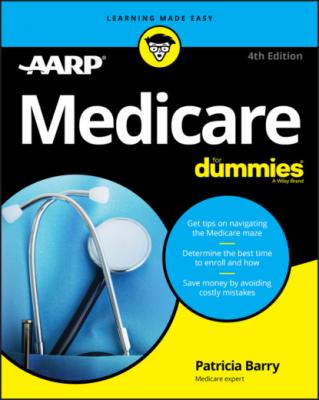Medicare For Dummies. Patricia Barry
Чтение книги онлайн.
Читать онлайн книгу Medicare For Dummies - Patricia Barry страница 11

Part A
Medicare Part A is usually described as hospital insurance — a term originally coined to distinguish it from medical insurance (Part B). But the phrase is misleading. “Hospital insurance” sounds as though Part A covers your entire bill if you’re admitted to a hospital, but it doesn’t work that way. The services you receive from doctors, surgeons, or anesthetists while you’re in the hospital are billed separately and are covered under Part B. And you don’t even have to be hospitalized to get services under Part A, because some are provided in settings outside the hospital or even in your own home.
The services of professional nurses when you’re admitted to a hospital or a skilled nursing facility (such as a nursing home or rehab center) for short-term stays or when you qualify for home health services or hospice care in your own home
A semiprivate room in the hospital or nursing facility
All meals provided directly by the hospital or nursing facility
Other services provided directly by the hospital or nursing facility, including lab tests, prescription drugs, medical appliances and supplies, and rehabilitation therapy
All services provided by a home health agency if you qualify for continuing care at home, as explained in Chapter 2
All services provided by a hospice program if you choose to stop treatment for a terminal illness, as explained in Chapter 2
The vast majority of people in Medicare are eligible for Part A services without paying any premiums for it. That’s because Part A is essentially paid for in advance by the Medicare payroll taxes that you or your spouse contributed from every paycheck while working. I explain the details of how that setup works — and your options if you don’t qualify for premium-free Part A — in Chapter 5.
But of course Part A services themselves aren’t free. You still pay deductibles and co-payments for specific services. I itemize these costs in Chapter 3 and explain how you may be able to lower them in Chapter 4. I also provide more-detailed information on certain Part A coverage issues in Chapters 2 and 14.
Part B
Approved medical and surgical services from any doctor who accepts Medicare patients, whether those services are provided in a doctor’s office, in a hospital, in a long-term-care facility, or at home
Diagnostic and lab tests done outside hospitals and nursing facilities
Preventive services such as flu shots, mammograms, screenings for depression and diabetes, and so on, many of which are free
Some medical equipment and supplies (for example, wheelchairs, walkers, oxygen, diabetic supplies, and units of blood)
Some outpatient hospital treatment received in an emergency room, clinic, or ambulatory surgical unit
Some inpatient care in cases where patients are placed under observation in the hospital instead of being formally admitted
Inpatient prescription drugs given in a hospital or doctor’s office, usually by injection (such as chemotherapy drugs for cancer)
Some coverage for physical, occupational, and speech therapies
Outpatient mental health care
Second opinions for non-emergency surgery in some circumstances
Approved home health services not covered by Part A
Ambulance or air rescue service in circumstances where any other kind of transportation would endanger the patient’s health
Free counseling to help curb obesity, smoking, or alcohol abuse
You must pay a monthly premium to receive Part B services unless your income is low enough to qualify you for assistance from your state. Most people pay the standard Part B premium, which is determined each year by a formula set by law ($144.60 in 2020). If your income is over a certain level, however, you’re required to pay more.
You also pay a share of the cost of most Part B services. In traditional Medicare, this amount is almost always 20 percent of the Medicare-approved cost. Medicare Advantage health plans charge different amounts — usually flat dollar co-pays for each service. I go into detail about the out-of-pocket costs for Part B in Chapter 3, and I explain ways to lower them in Chapter 4.
Part C
In the previous two sections, I describe coverage provided by Part A and Part B, which together form what is known as traditional or original Medicare — so named because that was the extent of the program’s coverage when it began back in 1966. It’s also called fee-for-service Medicare because each provider — whether it’s a doctor, hospital, laboratory, medical equipment supplier, or whatever — is paid a fee for each service.
But these days Medicare also offers an alternative to the traditional program: a range of health plans that mainly provide managed care through health maintenance organizations (HMOs) or preferred provider organizations (PPOs). These plans are run by private insurance companies, which decide each year whether to stay in the program. Medicare pays each plan a fixed fee for everyone who joins that plan, regardless of how much or little health care a person actually uses. This health plan program is called Medicare Advantage or Medicare Part C.
Still,

